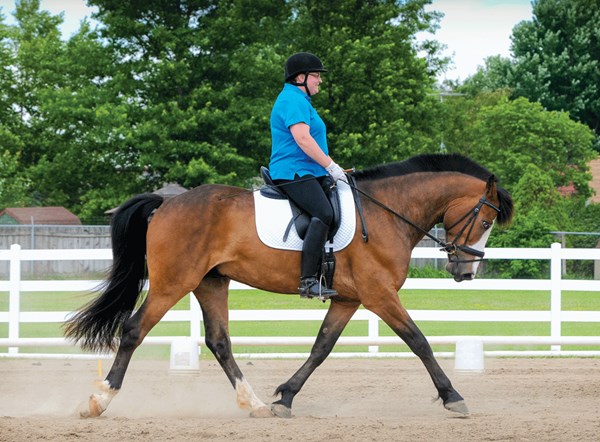
The picture of Wendy Siegel above shows her 4-year-old draft-cross, Ted, at Training Level at a local schooling show. Schooling shows can be a very good introduction for young horses to gain confidence and experience in the tests. The picture and video (http://bit.ly/1FbOSph) that Wendy provided shows a steady and fault-free test, and they were rewarded with a score of 73 percent. In this photograph, Ted shows nice balance and correct, free movement in the working trot. For Training Level, he should not be any higher in the neck. His noseline is slightly behind the vertical in the photo, but he clearly is not pulled back there and does not appear to be behind the vertical in the provided video. I have more of the impression that he just needs to develop a little more strength in his back to allow his nose to come more forward.
Ted appears fluid and active in his hind end. This picture was taken at precisely the right moment, as it shows how far his hind legs reach under his body. If you were to draw a vertical line straight up from where the hind leg is touching the ground, you could see that this line is slightly behind Wendy’s back. Ted needs to learn to step farther under his rider’s weight to be able to lighten his shoulders. If he keeps stepping slightly shorter than the center of gravity, his active and quick hind legs will need to hurry to keep him in balance and his movement will be more downhill toward his shoulders. This concept is similar to when you balance a whip on your fingertip: Once it tips forward, you have to move quickly to stay under it.
In the video that Wendy provided, I can see that Ted is moving along in the right direction. I like his steady rhythm and his forward attitude throughout the whole test. In the next step of training, he should learn to use his forward energy as more carrying energy, and this will lift his shoulders, making him look lighter. Wendy really does a good job in guiding and aiding this young horse through the test. She has very good balance, which shows how important a rider’s steady balance is for a young horse.
To improve their work together, I would like to see Wendy ride with a little more positive tension in her upper body. This should help Ted lighten his shoulders without making Wendy feel like she needs more contact on the reins. Once a trainer in a clinic told me to sit as though my legs were preparing for a super-extension while my hands became light and soft, preparing to stretch the horse. All of this, of course, is controlled by the upper body holding the horse in balance.
Try this: Wendy can try to use “breathing out” to increase her upper- body stability without creating negative tension. Especially in the transitions, she should imagine lengthening her body while squeezing the air out of her chest. Every time she attempts to slow her horse down or half halt, she should think of stretching her stomach muscles and lifting her chest a little upward to encourage Ted to lift his chest and lighten his shoulders. This will give her more precise control of her aids during transitions. It is nice to see a young horse that is well on his way. I wish Wendy many happy hours with her lovely young horse.











